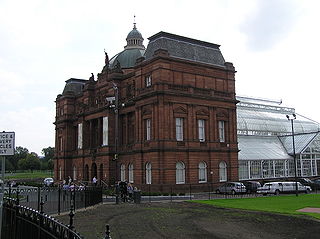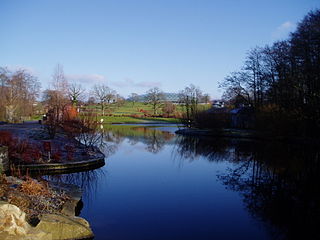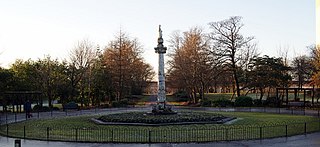
In the United Kingdom, a listed building is a structure of particular architectural and/or historic interest deserving of special protection. Such buildings are placed on one of the four statutory lists maintained by Historic England in England, Historic Environment Scotland in Scotland, Cadw in Wales, and the Northern Ireland Environment Agency in Northern Ireland. The classification schemes differ between England and Wales, Scotland, and Northern Ireland. The term has also been used in the Republic of Ireland, where buildings are protected under the Planning and Development Act 2000, although the statutory term in Ireland is "protected structure."

A conservatory is a building or room having glass or other transparent roofing and walls, used as a greenhouse or a sunroom. Usually it refers to a space attached to a conventional building such as a house, especially in the United Kingdom. Elsewhere, especially in America, it can often refer to a large freestanding glass-walled building in a botanic garden or park, sometimes also called a palm house if tall enough for trees. Municipal conservatories became popular in the early 19th century.

The People's Palace and Winter Gardens in Glasgow, Scotland, is a museum and glasshouse situated in Glasgow Green, and was opened on 22 January 1898 by The 5th Earl of Rosebery.

Glasgow Botanic Gardens is a botanical garden located in the West End of Glasgow, Scotland. It features several glasshouses, the most notable of which is the Kibble Palace.

The Adelaide Botanic Garden is a 51-hectare (130-acre) public garden at the north-east corner of the Adelaide city centre, in the Adelaide Park Lands. It encompasses a fenced garden on North Terrace and behind it the Botanic Park. Work was begun on the site in 1855, with its official opening to the public on 4 October 1857.
Springburn Museum was set up in the reading room of the Springburn Library, Glasgow, Scotland, as the first independent community museum in the city, presenting material on the industrial heritage of the area.

Springburn is an inner-city district in the north of the Scottish city of Glasgow, made up of generally working-class households.

Glasgow Works, formerly the St Rollox Works, is a railway rolling stock heavy maintenance and repair works established in the 1850s in the Glasgow district of Springburn by the Caledonian Railway Company, and known locally as 'the Caley'.

The National Botanic Garden of Wales is a botanical garden located in Llanarthney in the River Tywi valley, Carmarthenshire, Wales. The garden is both a visitor attraction and a centre for botanical research and conservation, and features the world's largest single-span glasshouse, measuring 110 m (360 ft) long by 60 m (200 ft) wide.

Dumfries House is a Palladian country house in Ayrshire, Scotland. It is located within a large estate, around two miles (3 km) west of Cumnock. Noted for being one of the few such houses with much of its original 18th-century furniture still present, including specially commissioned Thomas Chippendale pieces, the house and estate is now owned by The King's Foundation, a charity which maintains it as a visitor attraction and hospitality and wedding venue. Both the house and the gardens are listed as significant aspects of Scottish heritage.

St. Peter's Seminary is a former Roman Catholic seminary near Cardross, Argyll and Bute, Scotland. Designed by the firm of Gillespie, Kidd & Coia, it has been described by the international architecture conservation organisation Docomomo International as a modern "building of world significance". It is one of only 42 post-war buildings in Scotland to be listed at Category A, the highest level of protection for a building of "special architectural or historic interest". It has been abandoned since 1987, and is currently in a ruined state. In July 2020, the site was given to the Kilmahew Education Trust Ltd who plan to reinstate the educational elements of the Seminary Complex after conservation and restoration.
Save Britain's Heritage is a British charity, created in 1975 by a group of journalists, historians, architects, and planners to campaign publicly for endangered historic buildings. It is also active on the broader issues of preservation policy. SAVE is a registered charity governed by a board of trustees.
An annual Heritage at Risk Register is published by Historic England. The survey is used by national and local government, a wide range of individuals and heritage groups to establish the extent of risk and to help assess priorities for action and funding decisions. This heritage-at-risk data is one of the UK government's official statistics.

Mavisbank is a country house outside Loanhead, south of Edinburgh in Midlothian, Scotland. It was designed by architect William Adam in collaboration with his client, Sir John Clerk of Penicuik, and was constructed between 1723 and 1727. The first Palladian villa in Scotland, it is described by Historic Scotland as "one of Scotland's most important country houses." It was altered in the 19th century, but suffered decades of neglect in the 20th century. The interiors were gutted by fire in 1973, and the house remains a ruin, described by Colin McWilliam in 1978 as a "precarious shell.". In 2024, a grant of £5.3 million was given to stabilise the building and to enable up-to-date surveys of its condition to be made.

McLean's Mansion is a homestead in Christchurch, New Zealand. The two hectares property is situated between Manchester and Colombo Streets. The mansion was initially known as 'Holly Lea', but later became known as McLean's Mansion after its initial owner. It is the largest wooden residence in New Zealand. The mansion, designed by Robert England, architect of Christchurch, is a fusion of styles of Jacobean architecture and Victorian features, akin to the Mentmore Towers (1852–54) of Sir Joseph Paxton in Buckinghamshire in England. It was built between April 1899 and September 1900. The house is registered as a Category I heritage building by Heritage New Zealand. After the 2011 Christchurch earthquake, the owners applied to demolish the earthquake-damaged buildings, but their request was denied by the heritage body and the courts. In December 2016, the building sold to a trust that will restore it for use as a gallery. Restoration is expected to be finished by 2024.

Paul John Sweeney FIES is a Scottish politician. A member of the Scottish Labour and Co-operative Party, he currently serves as Member of the Scottish Parliament (MSP) for the Glasgow region in the 6th Scottish Parliament, elected in May 2021. He previously served as Member of Parliament (MP) for Glasgow North East from 2017 to 2019.
Bellevue is a district of Edinburgh, the capital of Scotland. It lies to the south east of Canonmills, west of Leith Walk and south of Leith, incorporating the easternmost extent of Edinburgh's New Town UNESCO heritage site. The area was formerly open fields which became the second and penultimate location of the Royal Botanic Garden in 1763 .

The Church Street School swimming pool is a category C listed building in Glasgow, Scotland. It was built in 1904 as part of the redevelopment of the school by the local authority. The school closed in 1976 but the pool remained in use as a public facility until its closure in 1997. The building has remained unused since then, though the school now serves as offices for Glasgow City Council's health and social care team. The structure has fallen into disrepair and has been listed on the Buildings at Risk Register for Scotland since 1999. A redevelopment of the site is planned by the council.

Springburn Park is a park situated in the north of the city of Glasgow, Scotland. The 31-hectare (77-acre) park lies about 2+4⁄5 miles (5 km) north of the city centre, and takes its name from the surrounding Springburn district of the city.

Springburn Public Halls was a public events venue on Millarbank Street in Springburn, part of Glasgow, Scotland. The building, which was derelict for three decades before being demolished in 2012, was a Category B listed building.




















